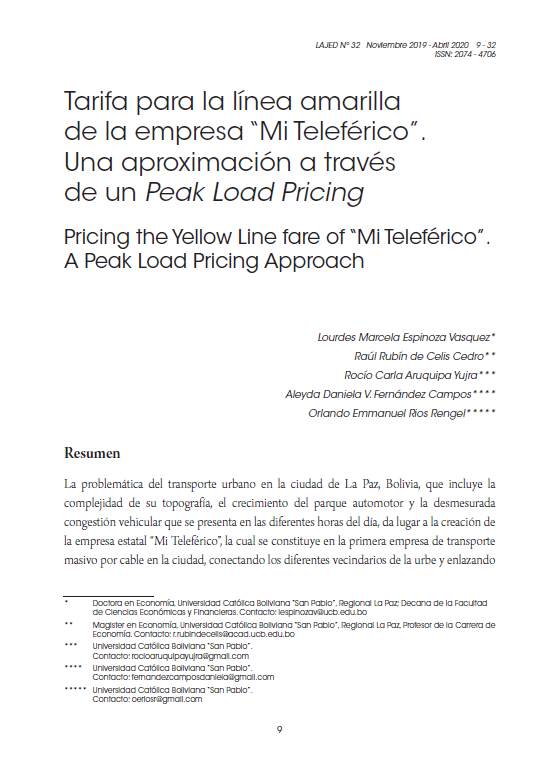Pricing the Yellow Line fare of “Mi Teleférico”. A Peak Load Pricing Approach
DOI:
https://doi.org/10.35319/lajed.201932394Keywords:
Peak Load pricing, Capacity, Cable Car, Rotation, Marginal Cost.Abstract
The problem of urban transport in the city of La Paz, Bolivia, which includes the complexity of its topography, the growth of the car fleet and the excessive vehicle congestion that occurs at different times of the day, leads to the creation of the public company “Mi Teleferico”, which is the first mass cable transport company in the city, connecting the different neighborhoods of it and linking the cities of La Paz and El Alto. This transport service is characterized by having an installed capacity that allows it to meet the different demands that arise in a day, providing a technological solution, compatible with the characteristics of the city and the requirements of consumers.
Given the importance of this mode of transport and the recognition that there is a high turnover during the day, this work focuses on the tariff setting for cable transport, in particular for the yellow line of the company “Mi Teleferico” through the establishment of a peak-load. It starts by applying the peak-load in the Firm Peak mechanism, where the prices of the valley and peak period are equal to the marginal costs of operation and capacity, for which a survey of information on passenger traffic, operating costs of the yellow line have been carried out, and other relevant variables for the years 2016 and 2017.
The results show that there is greater rotation of cabins in the periods considered peak and less rotation in valley periods. The above would be showing signs of the need to review the current rate in order to guarantee service sustainability.
Downloads
References
Boiteux, M. (1960). “Peak-load pricing”. The Journal of Business, 33(2), 157-179.
Braeutigam, R. R. (1989). “Optimal policies for natural monopolies”. Handbook of industrial organization, 2, 1289-1346.
Church, J. R. y Ware, R. (2000). Industrial organization: a strategic approach. Boston: Irwin McGraw Hill.
De Rus Mendoza, G., Campos, J. & Nombela, G. (2003). Economía del transporte. Antoni Bosch editor.
Mi Teleferico. (2014). !Sincronia Perfecta! El tendido de cables lineas amarilla y verde.
---------- (2016). Audiencia inicial de rendicion publicas de cuentas gestion 2016.
---------- (2017). Audiencia final de rendicion publicas de cuentas gestion 2017.
---------- (2018). Los numeros de “Mi Teleferico” gestion 2017-2018.
---------- (2019). Los numeros de “Mi Teleferico” gestion 2014-2019.
---------- (2018). Memoria “Mi Teleferico” gestion 2017-2018.
Rantzien, V. H. A. & Rude, A. (2014). “Peak-load pricing in public transport: a case study of Stockholm”. Journal of Transport Literature, 8(1), 52-94.
Steiner, P. O. (1957). “Peak loads and efficient pricing”. The Quarterly Journal of Economics, 71(4), 585-610.
Viscarra, F., M. A. (2017). Tarifa para el transporte “Mi Teleférico”: discriminación de precios. Universidad Catolica Boliviana “San Pablo”, La Paz, Bolivia.






